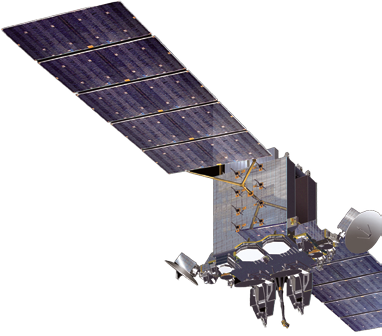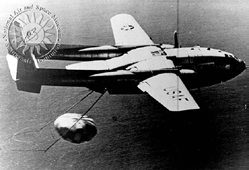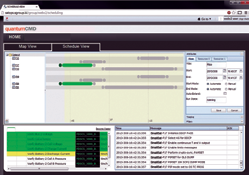Few of us can watch that remarkable scene in the movie Apollo 13 and not get inspired when Gene Kranz (played by Ed Harris) declares, “Gentlemen, failure is not an option!” The drama is stirring; but while drama is great in movies, it’s something nobody wants anywhere near satellites in the real world.

C2 systems are entering a new stage in their evolution capitalizing on technologies to improve performance and reduce cost. The shift is possible because COTS-based products, like Epoch from Kratos, broke the historical chain that tied C2 to a satellite, enabling mixed fleets, such as the U.S. Air Force’s CCS-C program which runs four constellations, including the AEHF (pictured left. image courtesy of Lockheed Martin).
Let’s face it. Command & Control (C2) is not the most glamorous part of satellite missions. If it has one underlying principle, it is to avoid drama. C2’s driving business question is: How can we reduce risk, while flying more satellites at lower cost? Emphasis on the reduced risk.
Satellite C2 is conservative because it is simply not worth taking chances with billions of dollars in infrastructure simply to achieve incremental benefits. However, it is also dynamic because it is the core system that unites all the ConOps elements: people, payload, vehicle, ground equipment and network.
Business and mission imperatives have driven consistent progress in C2 technology over time, and we have reached a point when significant advances are being made on
several fronts, such as applying broader IT trends like virtualization and “big data” analysis, as well as leveraging new computing platforms and operating systems. We can explore these new directions because the evolution of C2 systems has provided a stable, reliable environment for operating satellite fleets, and how we got here laid the foundation for the next wave of advancements.
Inventing C2: Creating A Stable Platform
Historically, the primary challenge for C2 systems involved how to safely manage the growing number and diversity of satellites.
From the beginning, the original engineers in the 1950s were conceiving all elements of a satellite mission for the first time, and they designed the pieces together, inseparable from each other. The pattern was formed with the U.S. Air Force’s policy decision to acquire a complete satellite system for the Advanced Reconnaissance System (ARS), using the name “Subsystem H” to refer to the ground segment. By the time of Discoverer 14 (the U.S.’s first successful retrieval of a satellite reconnaissance package), the Air Force Satellite Control Facility (AFSC) was supporting three military satellite programs, each “using a different combination of remote tracking stations with significantly different tracking equipment, personnel, performance quality, and methods of operation,” according to David Arnold in Spying From Space.
For decades, custom C2 systems were the norm in government and commercial applications. They were usually developed by the manufacturer and delivered as a combined entity with the satellite. Still, as early as 1960, the U.S. Department of Defense and NASA began thinking about how to fly more satellites with fewer people and less equipment by exploring the possibility of a C2 system to support both agencies. To operate multiple satellites, however, ops teams would need the first big advancement in C2, the capability to simultaneously operate multiple satellites using a single C2 system or multiple copies of the same C2 system.
By the late 1960’s, the need became more acute as large organizations like Intelsat and the U.S. Air Force started buying “series” of satellites (a set of satellites from the same manufacturer with the same basic specifications, particularly relating to the bus subsystems) and using the same basic C2 system to operate the entire series.
The next major step for C2 systems would be operating fleets of diverse satellites. In the late 1980s, NASA and Integral Systems (ISI), now Kratos ISI, worked together to build the Transportable Payload Operations Control Center (TPOCC), a system designed to simultaneously operate many satellites with different designs from different manufacturers. TPOCC was a leap forward, however, it was still a custom solution, built for and used by just one organization.
The greater impact came later, with ISI’s creation of EPOCH, the first commercial off-the-shelf (COTS) satellite control product. This database-driven system broke the fixed satellite/C2 connection by accommodating each satellite’s unique monitor and control requirements via common user interfaces and tools. Now, any operator could control a fleet of satellites of varying designs from different manufacturers, all from a single system or even a single workstation.
By eliminating the need for multiple C2 systems, EPOCH drove down the procurement and O&M costs by millions of dollars. It was the first of several products that would enter the market once the viability of a COTS approach had been proven. The timing could not have been better, coinciding as it did with the telecom boom of the late 1990s as both larger, established operators and smaller, new players increased the size and diversity of their fleets.
To cap it off, in 2001, the largest satellite operator at the time, the U.S. Air Force, applied the COTS model to its fleet with the Command and Control System-Consolidated (CCS-C) program. CCS-C replaced the custom system developed in the 1970s with an EPOCH-based solution that cost about half as much to operate and maintain, helped reduce staff levels by 75 percent and lowered sustainment costs by 85 percent. Today, CCS-C operates four constellations in a single consolidated system.
A Foundation For Future Growth
The development of reliable, manufacturer-independent C2 systems marked the transition to a new stage in satellite C2 systems evolution by establishing a mature marketplace with core feature/function sets. As manufacturers introduce new satellites and new buses, proven C2 systems have established models for addressing each new platform they are asked to accommodate.

Discoverer 14 was the first successful launch of the Corona spy satellite by the U.S. On September 20, 1960, the successful return of the satellite was managed via a mid-air capture. Photo is courtesy of the Smithsonian Institution’s National Air and Space Museum.
Similar to the evolution in cell phones, enterprise software, and other advanced technology markets, today the focus in C2 has shifted toward finding competitive differentiation that supports an operator’s ability to address future business and mission drivers. Rather than one main thread of innovation, enhancements are being made along multiple paths that will help operators capitalize on the explosion of telecom and network services, advancements in communication technology and growing globalization. As always, the primary directive will be to enhance reliability, performance and efficiency while reducing cost and risk. The groundwork for most of these paths was laid during the early days of C2 development.
Big Data Return From A Little Integration
From the start, the satellite industry has balanced the stovepiped technologies it employs with an overarching systems engineering approach that unified complex, specialized domains. C2 systems can be a hub for uniting these technical “spokes,” especially as operators look for ways to maximize value. As a result, we’ll continue to see efforts toward broader and deeper integration of key systems (or at least their data) to get a clearer picture of the internal and external forces affecting the satellite.
Satellite systems have always handled tremendous amounts of diverse kinds of information, so data integration is nothing new, however, sophisticated analytics capabilities to turn this data into actionable information are still fairly limited. For example, combining telemetry data with satellite RF behavior information can allow operators to more accurately trend the performance of a transponder and predict end of life for amplifiers and other key components.
Similarly, as teleport equipment failures can cause changes in satellite transponder telemetry data, setting up alarms in the Management and Control (M&C) system for correlation in the C2 system can save time and effort wasted chasing down false problems. And automatically applying the right analytics to information such as space weather data can help explain and predict some anomalous behaviors.
In addition, modern IT techniques can be employed to automate and increase the speed of archive data processing, applying advanced correlations to operating trends as well as detecting changes in operating parameters. Similarly, advanced analytics can be applied to telemetry data to characterize the satellite performance for diurnal cycles, seasonal cycles and specific events. These mathematical characterizations can then be applied to identify non-nominal events faster and more accurately, allowing for immediate identification of changes in satellite performance for an early indication of a failing or impaired unit
Streamlining Operations With Automation
The potential benefits of automating operations were recognized early in satellite C2’s evolution, from the time manufacturers first started addressing the challenge of flying multiple satellites simultaneously. Hughes (now Boeing), for example, developed a set of procedures early on that greatly simplified the operations of their 376 geostationary communications satellites and later models.
This seemingly small advance helped many new operators in countries around the world join the space club by enabling them to more confidently operate their first satellites. Automation features have progressed from command lists to procedure scripts to graphical procedures using flowchart-like displays.
Constantly pushed by its terrestrial competition to provide greater value, satellite C2 systems will continue to add automation facilities as one way to provide more innovative services at lower cost. This will include the automation of routine recurring operations and recovery from well known failure modes, such as closed loop operation of low thrust propulsion and rapid configuration of communications payloads, among others.
Still, automation can be viewed as the poster child for C2’s risk/reward equation, so the safety and reliability of any automation improvement always has to be proven first. As noted, it’s not worth risking a multi-hundred million dollar satellite for the chance at saving a few hundred thousand dollars in productivity. That’s why today’s automation features always allow a human in the loop who can be required to push the button before a key decision is made or command is sent.
The burgeoning small satellite market is one area paying increased attention to automation, in part because its less expensive satellites invert the risk/reward equation and make operations the more dominant cost factor. At Kratos, we are already seeing customers explore ConOps that range from partial to fully “lights out” missions as more small sats are launched.
Evolving IT Platforms + Architectures
The satellite is not the only form of hardware that is driving C2 evolution, so is the ground equipment that hosts the systems. It’s staggering to compare today’s technology environment to that employed by the Vanguard mission in the 1950s, as described by Constance Green and Milton Lomask in Project Vanguard: The NASA History, in which information was sent from the tracking sites by teletype to the computing station in Washington, DC, and entered into an IBM-709 “electronic calculator,” leased to the government for $900,000 for six weeks.

The growth in small satellites is also driving new innovations in C2, including increased attention to fleet control and automation capabilities, such as those reflected in quantumCMD, the new COTS product from Kratos for small sats and small sat fleets. There’s more info at http://www.kratostts.com/page/quantumCMD
Since then, the satellite industry has benefited from parallel waves of computing evolution, progressing through the IT boom of the 1970s, the PC revolution of the 1980s and the Internet-enabled communications of today.
Advancements in processors, servers, ground equipment and network devices will continue to enable C2 innovation system as designers capitalize on improving power, performance and price. As always, it will be done cautiously, however.
Consider, for example, that at a time when many satellite operators have only relatively recently fully adopted the PC environment and integrated their C2 operations with applications like MS Office, a powerful new platform is taking the world by storm. Research firm BI Intelligence reports that the global per-capita rate of smart phone ownership beat that of PCs sometime in 2012 and tablets are not far behind. These devices are already being used for mobile and remote satellite monitoring and analytics applications, though using them more broadly to actually control satellites is likely some time off.
Virtualization is a related trend that is already having significant impact, not just in C2 systems, but across all of satellite operations. Here, the risk/reward balance is far clearer, with plenty of data available showing how virtual systems can reduce costs and improve reliability.
With virtual systems, all software can reside in a central processing center accessed via thin clients. This greatly reduces O&M costs by eliminating software on end user computers, lowering maintenance and support expenses and making systems upgrades far easier. Because systems can be run in the cloud on dedicated servers—whether a secure environment at the operator’s facility or a third-party server farm—reliability can be increased through automated redundancy and the ability to easily add processing power as needed.
Some Kratos customers have already implemented fully virtualized facilities using VMware, Citrix and similar environments. Several use Kratos’ Webic (a thin client specifically designed for satellite C2) in implementations ranging from telemetry and archive data monitoring and analysis up to a full C2 system user interface.
Beyond C2, virtualization is being applied in the satellite industry in remarkably innovative ways, from telemetry signal processing (historically a hardware-based function) to virtualizing antenna assets by separating the signal processing from the RF/antenna systems. What’s more, by centralizing mission critical systems, virtualization helps address another important trend, physical security and cybersecurity.
Greater Emphasis On Security
Back in 1969, the U.S. Air Force Satellite Control Facility added encryption and decryption technology in its new Space-Ground Link Subsystem (SGLS) in part to deter eavesdroppers. Today, pressure to enhance security will become an increasingly louder drumbeat, not just in the U.S., where satellites have been designated as “critical infrastructure” and are subject to new, more stringent cybersecurity requirements and government contracting regulations, but around the world as the global nature of the threat to government and commercial systems grows.
Across the satellite industry, organizations have historically relied upon an “air gap” defense, assuming that walling off the satellite network kept it safe from cyber threats. Unfortunately, this approach creates a false sense of security. There have been several well-publicized examples demonstrating the weaknesses of such strategies, most notably the Stuxnet worm. More importantly, most operators must provide their engineers with external access to systems for operations and rapid response to problems, thus poking holes in their air gap.
To date there have only been a handful of publicly reported cyber attacks on satellites, such as the NASA Landsat and Terra command link hacking events. It’s ironic, but in the security realm, our natural conservatism may leave us at greater risk if protection against cyber-related threats are not taken seriously enough until after the first truly calamitous event occurs. In the mean time, there is little doubt that cybersecurity and information assurance (IA) pressures will increase, affecting all systems including C2.
Small Sats + Smart Sats: Laboratories For Experimentation
Other exciting directions can be seen on the horizon, such as smart satellites that build more C2 functions for nominal and contingency operations directly onto the satellite. This is a trend that has been growing slowly for years as space-qualified processors have improved; and it will continue in order to reduce operating effort and in recovering from well-defined failure modes. It will also demand that operators adjust their processes and training procedures, however, to assure that the staff and the C2 system are equally ready for “non-well-defined” failures. An effective recovery process requires that users understand what failed (or at least what happened) on the satellite, as well as what automated onboard recovery the satellite will take.
Another fertile area that will have an impact on the industry are small sats, CubeSats and their nano, pico and related cousins. The packages may be smaller, but they demand much of the same functionality from C2 systems as their larger cousins, with some new twists and turns to go with them. Most prominently, they must provide the same level
of robustness, reliability and security at much lower cost, both initial capital cost as well as supporting a much lower and more automated operations cost.
One of many reasons Kratos is investing in the small satellite community is that we believe it will become an exciting laboratory for innovation, including its ground equipment, networks, monitoring and C2 systems. While the cost of the satellites are still relatively high, they can be a fraction of those of traditional missions, and therefore carry a more balanced risk/reward equation relative to operations costs. Hopefully, this will enable more innovation and faster adoption of new techniques and technologies in areas such as automation, data analysis and virtualized operations.
Earlier this year Kratos introduced its new small satellite C2 product, quantumCMD, targeted specifically at the mission needs and price points of small satellite operators. We are also working on small satellite-friendly solutions in other areas, such as telemetry RF signal processing. The lessons learned in this space will allow the industry to perfect new techniques that can be proven with small sats, then safely migrated upstream to larger satellite operations.
About the author
Stuart C. Daughtridge is Vice President of Advanced Technology at Kratos Defense & Security Solutions, where he has been instrumental in developing the company’s full line of satellite communications products and services. He joined Kratos with its acquisition of Integral Systems in 2011. Previously, he held several management and engineering positions at Orion Satellite Corporation, Intelsat and Spacecom.

